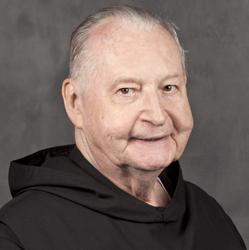
Fr. Columba Kelly, OSB, 87, a monk and priest of St. Meinrad Archabbey, St. Meinrad, Indiana, died on June 9 at the monastery. He was a jubilarian both of profession and priesthood. Born in Williamsburg, Iowa, on October 30, 1930, he was given the name John Joseph at his baptism. He attended St. Ambrose College, Davenport, Iowa, for several years before transferring to St. Meinrad College. Invested as a novice monk on July 30, 1952, he professed simple vows on July 31, 1953, and his solemn vows on August 6, 1956. Fr. Columba completed his theological studies in Rome and was ordained to the priesthood on July 5, 1958. The following year, he received a licentiate in sacred theology from the Pontifical Athenaeum Sant’ Anselmo. He then pursued graduate studies, earning his doctorate in church music at Rome’s Musica Sacra in 1963. He studied semiological interpretation of chant under Dom Eugène Cardine, OSB, monk of the Abbey of Saint-Pierre in Solesmes.
When Fr. Columba returned to Saint Meinrad in 1964, he was named choirmaster of the monastic community and began to teach in both the College and the School of Theology. His lasting contribution was to introduce chant in English into the celebrations of the Divine Office and the Eucharist. The monastery’s collection of his chant compositions numbers nearly 2,000.
In addition to his many years teaching at Saint Meinrad, he taught courses on liturgical music for 12 summers at St. Joseph’s College, Rensselaer, Indiana. Other summer teaching assignments included University of Wisconsin, Madison, and California State University-Los Angeles. Through his many workshops to parishes and religious communities, and through the collections of his antiphons published by GIA and Oregon Catholic Press, his work is known by many cantors, choirs, and parish communities throughout the United States.
Fr. Columba was a charter member of the Benedictine Musicians of the Americas, a member of the American Musicological Society, the American Guild of Organists, the National Catholic Music Educators Association, the Church Music Association of America, and the Composers’ Forum for Catholic Worship. He was also a standing member of the Chant Division of the National Pastoral Musicians Association. In 2015, he was named the second recipient of the Spiritus Liturgiae Award, given by the Liturgical Institute in Mundelein, Illinois.
In addition to his music scores, Fr. Columba contributed to the literature on chant and sacred music. These include his 2003 book, Gregorian Chant Intonations and the Role of Rhetoric; “The Organ,” an article in a book sponsored by the National Liturgical Conference and the Church Music Association; and, in 2006, his translation of and notes to the first volume of Agustoni and Göschl’s An Introduction to the Interpretation of Gregorian Chant. Fr. Columba also contributed entries on the Kyrie, Gloria, Agnus Dei, Benedicamus Domino, and Ite Missa Est for the New Catholic Encyclopedia.
The funeral Mass for Fr. Columba Kelly was celebrated June 13. Burial followed in the Archabbey Cemetery.



